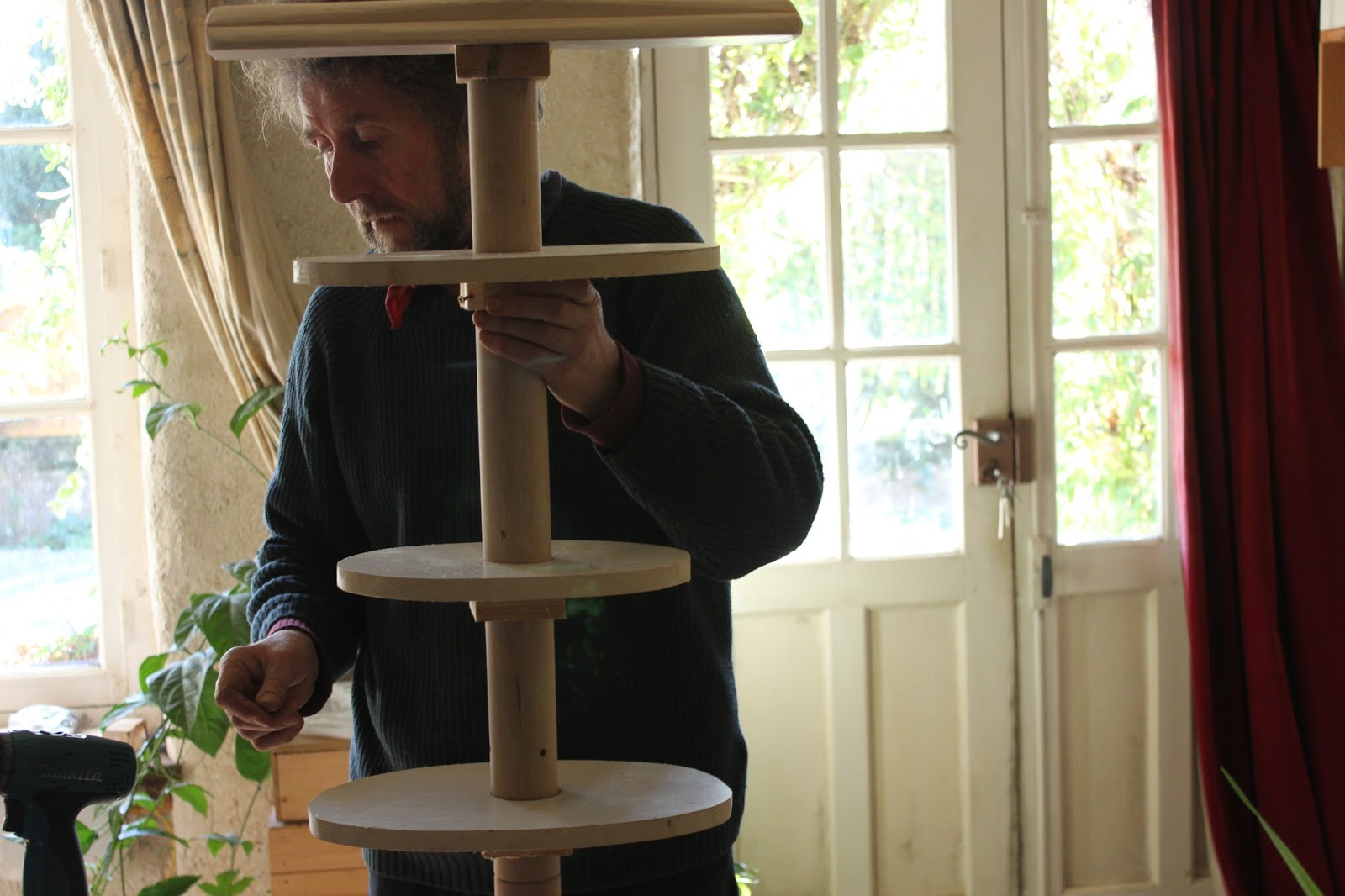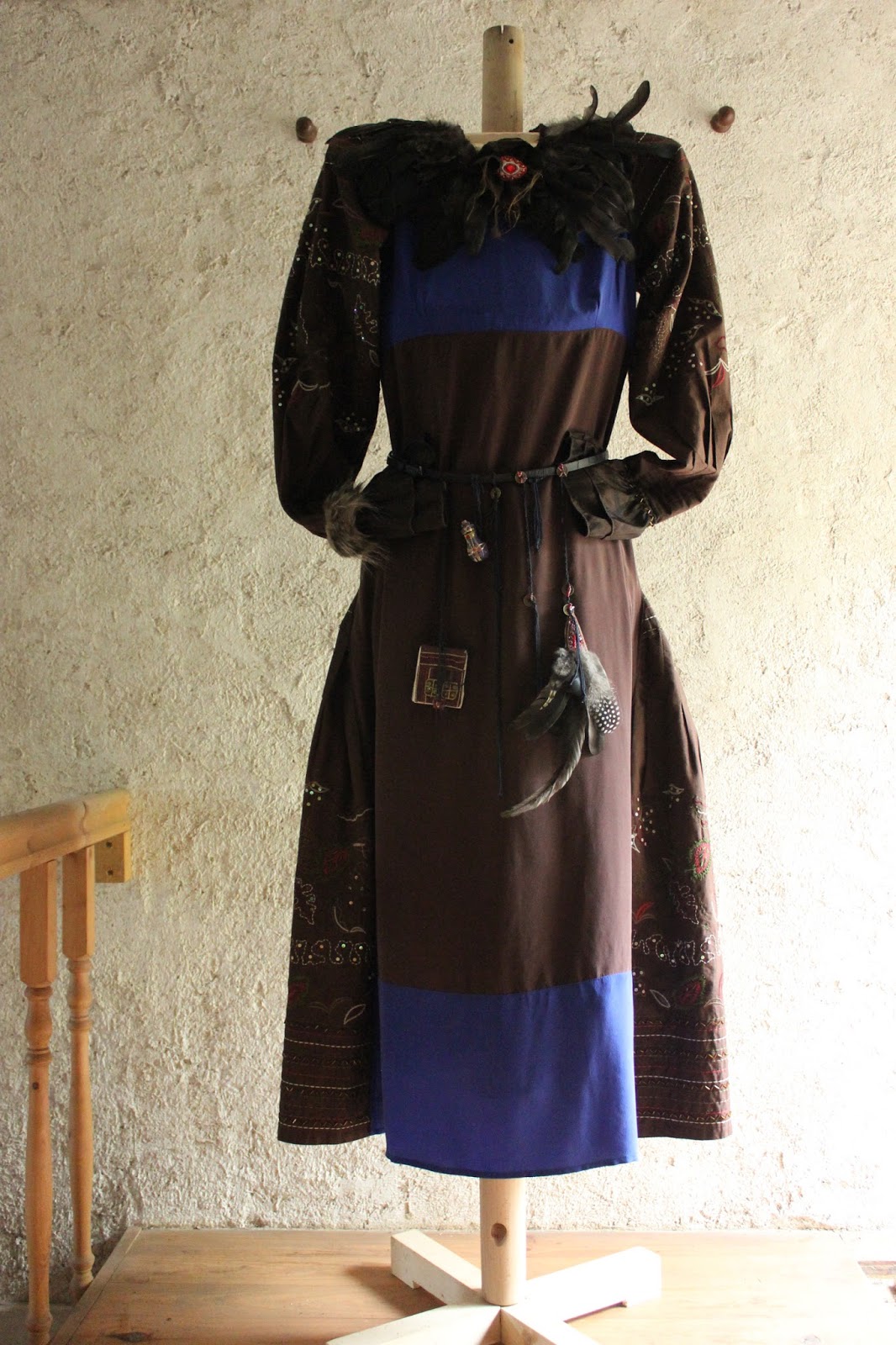Over the Christmas holidays, Sue was asked to make costumes for a new
small independent film company started by her niece Emily. As the budget
was tight and as Sue wanted to create a film wardrobe using the the
best possible fabrics and accessories, she decided to use as much
upcycled and refashioned textile and clothing as possible.



The actors and actresses are all in Scotland and as we are here in France, there was no possibility for fittings nor for making tee shirt and duct tape type DIY mannequins. So Sue had an idea that we could make dummies for all of the characters out of pallet wood. These would be constructed in a similar style to the wire dress forms which just cover the basic measurements viz shoulders, bust/chest, waist and hips. Once Emily had given us all the vital statistics we then went about sourcing a central pole on which to thread them. We are fortunate to have friends who own an organic shop, not only for the discarded vegetables for our poultry but also for pallets, shipping cases and from time to time old product display stands. A few weeks ago the latter came our way in the form of a 2 metre long wooden pole
Design
The most difficult part of the design, once we had gathered all the materials together, was in working out the distances between the key measurements but we eventually pieced together bits from several websites (included below). It was also really interesting to find how many variables there are in ‘standard’ sizes of clothing and how much better off we were tailoring the costumes to exact measurements rather than looking at labels. Below shows the diagram we worked from to ‘standardise’ our basic dummy measurements. As we were given the measurements individually and the ones we found on the web used different units we had quite a mix! However, as Sue was incorporating some vintage clothing into her designs, we did end up finding it useful to have both SI and imperial units.
Another useful measurement tip we picked up surfing around the net was that the bust to high shoulder measurement and the centre bust to waist line are variable according to dress size. Thus in the UK, for example, the bust to high shoulder length at size 8 is fixed at 10½" with an extra ¼" for each size above. So depending on the sizes you are dealing with and the units you are using - it is worth working this out before starting to assemble the dummy. Unless of course you want to measure everyone individually, which in the case of petite or very tall subjects you may need to do.
The great advantages of this type of dummy are:
Another useful measurement tip we picked up surfing around the net was that the bust to high shoulder measurement and the centre bust to waist line are variable according to dress size. Thus in the UK, for example, the bust to high shoulder length at size 8 is fixed at 10½" with an extra ¼" for each size above. So depending on the sizes you are dealing with and the units you are using - it is worth working this out before starting to assemble the dummy. Unless of course you want to measure everyone individually, which in the case of petite or very tall subjects you may need to do.
The great advantages of this type of dummy are:
- it can be stored away in a very small space once not in use,
- it is at a great height for working on and trying out designs.
- you can create any size for both men, woman and children on the same mannequin.
- it can even be made in stiff card if you have no wood available to make the form,
- by stretching a tee shirt over the form and/or padding it out with fabric you can make a great display stand for yard sales, craft fairs or for photographing items for sale on etsy or ebay
- if you are only going to use it once, you can recycle the materials into something else, even if it is just firewood and a curtain pole!
If you are wanting a dummy with more contour to it rather than just key measurements then you can make a padded fabric jacket to go over it or even just simply, a stretched tee shirt would work. This dummy could also be practical and decorative for someone selling home-made or vintage clothing and/or jewellery. As a display stand, it can be easily taken down and packed into the back of a car, in fact it will be going with us on an Upcycling Exhibition in April.
The key sizes of each actor were reproduced as ‘ovals’ in wood, which could then be positioned on the central pole at the appropriate positions.
Fabrication
The wooden pole had a diameter of 55mm, which was fortunate as I had a hole saw capable of cutting a hole 57mm in diameter. One end was slightly larger (61mm) for 200mm of the pole’s length, this was to be where the base was attached.
The Base
This was made from a pallet ‘stretcher’ 60mm(23/8”)x 45mm(13/4”) cut in half resulting in a length of 525mm (205/8”) for each one. I wanted the base to have ‘feet’ so that the entire length of the wood wasn’t touching the floor. I therefore used the circular saw to cut away 10mm from the bottom of each length leaving the last 64mm(21/2") at each end uncut.
To create the ‘X’ shape for the base the two pieces were assembled using a halving joint at the mid-point of each piece.
I used a 125mm (5”) long piece of M15 threaded rod to join the two pieces together. It was my intention to use the threaded rod to attach the base to the pole. Although the pitch of the thread on the rod was quite fine I believed it would be good enough to anchor itself into the wooden pole.
I needed to ‘help’ the rod make its path into the drilled hole in the pole and I did this using a tip my father showed me many years ago. By cutting one or more slots in the one end of the rod one effectively creates a crude tap, the slots make a cutting edge for forming the thread. Dad showed me this as a means of cleaning the threaded holes for spark plugs in a motorcycle cylinder head – he used an old spark plug as the ‘tap’.
Prior to drilling the through hole in the base, a 25mm diameter wood bit was used to make the rebate for the nut.


This was to ensure there was a clearance between the nut and the floor.
Attaching the Pole
Once the hole had been drilled, I made the thread in the pole (pictured above). I then used a router to create a recess in the pole’s bottom face as clearance for the M15 nut and washer. This done, the pole was screwed to the base.
Part Two also includes a film of the whole process.
If you've enjoyed this article and found it useful please feel free to share it or to comment and/or make observations.
All the very best and until next time,
All the very best and until next time,
Andy
© Andy Colley 2015
Some Useful Links for Sizing
Craft Yarn Council - Women's Size Charts
Long Tall Sally - International Measurements for Tall Women















